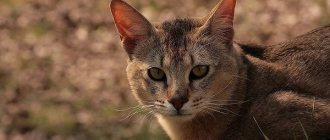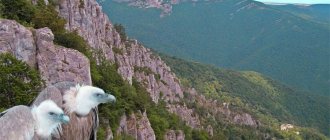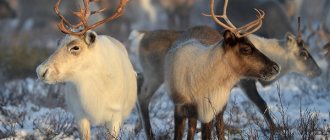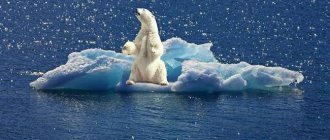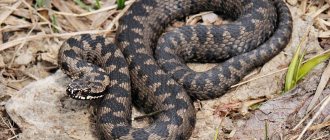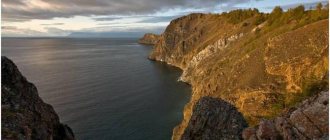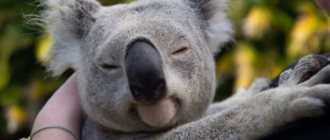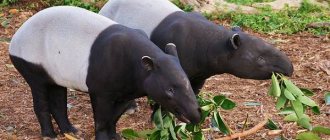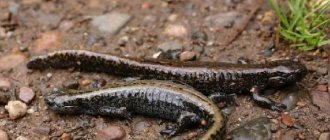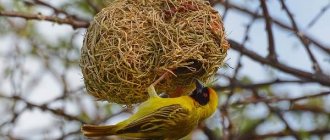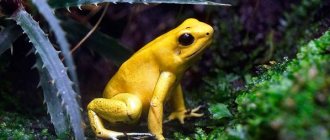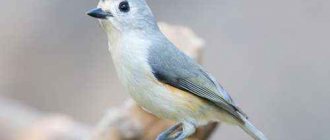The spaces located in the subequatorial belt are covered with grass vegetation, as well as sparsely scattered trees and shrubs. The sharp divisions of the year into rainy periods and dry seasons, typical for the subequatorial climate, are optimal conditions for the life of many animals. Many savannah areas are well suited for cattle breeding, but wild fauna have completely disappeared. However, large national parks still exist in the African savannah with animals that have adapted to survive in arid conditions.
Mammals
The fauna in the savannah is a unique phenomenon. Before the appearance of white colonizers in these territories, countless herds of large herbivores could be found here, making transitions in search of watering places. Such herds were followed by various predators, and then by typical carrion eaters. Today, the savannah is home to more than forty species of the largest mammals.
Giraffe
Thanks to its natural grace and impressive long neck, the giraffe (Giraffidae) became a real gem of the savannah, considered by its discoverers to be a cross between a leopard and a camel. The height of sexually mature adults varies, as a rule, in the range of 5.5-6.1 m, a third of which is at the neck. In addition to the unusual neck, giraffes have a tongue, the length of which reaches 44-45 cm. The diet of this savannah animal consists mainly of succulent foliage of trees.
Savannah elephant
The largest land mammal existing today, belonging to the genus of African elephants and the order Proboscidea. Savannah elephants (Loxodonta africana) are distinguished by a heavy and very massive body, thick limbs, a large head located on a rather short neck, huge ears, as well as a muscular and long trunk, very unusual upper incisors, which turned into strong tusks in the process of evolution.
Caracal
The desert or steppe lynx (Caracal caracal) is a predatory mammal from the cat family. Possessing a slender body, the animal is distinguished by ears with tassels at the ends and has a developed brush of hard hair on its paws, which makes it easier to move even through fairly deep sand. The fur color is similar to the North American puma, but melanistic caracals, characterized by a black color, are sometimes found in their natural habitat.
Greater Kudu
The African kudu antelope (Tragelaphus strepsiceros) is a savannah representative of the bull subfamily. The coat, as a rule, has 6-10 vertical stripes. The animal has rather large rounded ears and a relatively long tail. Males have large and screwed horns up to a meter long. In appearance, the greater kudu can be quite easily confused with the related nyala, whose natural habitats currently partially overlap.
Grant's Gazelle
One of the savannah representatives of the subfamily of True antelopes is Grant's gazelle (Gazella granti). The animal has high genetic differences within the population in the absence of geographic isolation. Species differentiation most likely occurred as a result of repeated expansion and contraction of arid habitats with complete isolation of populations of different numbers and external characteristics. Today, subspecies differ in morphological characters, including the shape of the horns and the color of the skin.
wild dog
The wild dog (Lycaon pictus) is a canid mammal and the only species of the genus Lycaon named after the Greek god. The animal is characterized by a short coat of reddish, brown, black, yellow and whitish coloring with a unique color for each individual. The ears are very large and round in shape. These dogs have a short muzzle, with powerful jaws, and strong limbs, perfectly adapted for chasing.
Rhinoceros
An odd-toed ungulate savannah mammal belonging to the relatively large rhinoceros family (Rhinocerotidae). The land pachyderm has a long and narrow head with a steeply sloping frontal area. Adult rhinoceroses are distinguished by a massive body and rather short, powerful and thick limbs, each of which has three fingers, characteristically ending in relatively wide hooves.
a lion
The main predator of the savanna (Panthera leo) is a relatively large mammal, a representative of the genus Panthera and the subfamily of big cats. Holding the record for shoulder height among cats, the lion is characterized by well-defined sexual dimorphism and the presence of a fluffy tuft - a “tassel” at the tip of its tail. The mane can visually increase the size of adult lions, which helps the animals intimidate other mature males and easily attract mature females.
African buffalo
The buffalo (Syncerus caffer) is a widespread animal in Africa, a typical representative of the subfamily and one of the largest modern bulls. The large bovid is covered with sparse and coarse black or dark gray hair, which noticeably thins with age until whitish circles appear. The buffalo has a dense and powerful build, has fairly wide front hooves and a long tail with a tuft of hair at the very tip.
Warthog
The African warthog (Phacochoerus africanus) is a member of the pig family and order of artiodactyls, inhabiting a large part of Africa. In appearance, the animal resembles a wild boar, but differs in its somewhat flattened and very large head. The wild animal has six quite clearly visible subcutaneous fat deposits, reminiscent of warts, which are symmetrically located along the perimeter of the muzzle, covered with gray skin.
Return to content
sausage tree
Very unusual (for a European) is the sausage tree growing in these places. It got its name thanks to the unusual fruits that grow up to 50 cm in length. According to local residents, they are used in the treatment of rheumatism and syphilis. In addition, it is a mandatory attribute in rituals to expel evil spirits.
Looking at a photo of the African savannah, you will notice that there are many different palm trees in these areas. And indeed it is. There are several types of similar trees here.
In addition, the flora is rich in thorny bushes and mimosas - a favorite delicacy of giraffes.
It should be noted that during a period of drought in the savanna, all vegetation seems to freeze: often during this period, trees completely shed their leaves, and the grass sometimes completely burns out under the hot sun. There are frequent fires here, which damage the vegetation.
But when the rainy season comes, the nature of Africa comes to life again. Fresh, lush grass appears and various plants bloom.
Birds
The natural conditions of the savannah provide an ideal habitat for birds of prey, including hawks and buzzards. It is in the savannah that the largest of the existing modern feathered representatives of the fauna, the African ostrich, is found today.
African ostrich
A flightless ratite bird from the ostrich family and the order Ostrichidae has only two fingers on its lower limbs, which is exceptional in the class of birds. The ostrich has expressive and rather large eyes, framed by very long eyelashes, as well as a pectoral callus. Adult individuals with a dense physique are distinguished by their height up to 250-270 cm, and are characterized by a very impressive weight, often reaching 150-160 kg.
Weavers
Weavers (Ploceidae) are representatives of the family of birds from the order Passeriformes. Adult small birds are distinguished by a rounded and relatively large head. Some weavers have a characteristic crest in the crown area. The bird's beak is conical and short, quite sharp. There are three longitudinal ridges on the palate, connecting at the back. The wings are short, rounded, and males differ from females in the size and sometimes color of their plumage.
Guinea fowl
The only species of the genus Numida has been domesticated by humans. Such savannah birds are distinguished by the presence of a horn-like process in the crown area and a fleshy red beard. The bird is characterized by a slightly hooked and laterally compressed beak of moderate size, as well as the presence of rounded wings and a short tail covered with covert feathers. The plumage is uniform, dark gray, with white rounded spots with a dark border.
Secretary Bird
The secretary bird is a hawk-like bird (Sagittarius serpentarius), distinguished by black feathers on its head, which characteristically rise during the mating season. The color of the plumage in the neck and belly is gray, becoming darker as it approaches the tail. There is no feathering around the eyes and up to the beak, and the orange skin is very visible. The average wingspan of an adult is 200-210 cm. Birds spend a significant part of their time moving relatively quickly on the ground.
Horned crows
African hornbills (Bucorvus) lead a terrestrial lifestyle. Quite large in size and heavy, representatives of the family have a wingspan of almost two meters. The body size of an adult is about one meter. The inhabitant of the African savannah is characterized by black plumage and the presence of bright red patches of skin on the head and neck. Juveniles have a black, straight beak, without a helmet, which is quite well developed in adult males.
Spur lapwings
The small savannah bird (Vanellus spinosus) has a body length of 25-27 cm. The head and chest area of such birds have black and white plumage. The upper part of the body is sandy or brown in color. The legs of the Spur Lapwing are black, noticeably prominent when flying over the tail. The flight is the same as that of lapwings - quite slow and very careful.
Return to content
Savannah vegetation
The predominant type of vegetation in savannas is grass. Although their landscape can be enlivened by bushes and trees - unlike the steppes, where only grass cover is observed. But the trees are mostly short, with crooked trunks. Shrubs may not be solitary; sometimes there are thickets.
African savanna
Reptiles and amphibians
Savannas and semi-desert areas are home to many reptiles and amphibians. The biotope is very characteristic of the tropics with elevated landscapes and arid climatic conditions. Reptiles, amphibians and reptiles serve as the main food for many savannah terrestrial and avian predators. There are few amphibians in the nature of the savannah, there are no newts and salamanders, but toads and frogs, turtles and lizards live. The most numerous reptiles are snakes.
Varan Komodo
The Komodo dragon, or Komodo dragon (Varanus komodoensis), can grow up to three meters or more in length, weighing up to 80 kg. Top predators are distinguished by a dark brown color, usually with the presence of small yellowish spots and specks. The skin is reinforced with small osteoderms. The youngest individuals have a different coloration. The large and sharp teeth of the monitor lizard are perfectly adapted for tearing even very large prey.
Jackson's Chameleon
Lizards from the chameleon family got their name (Trioceros jacksonii) in honor of the famous explorer Frederick Jackson. The body length reaches 25-30 cm. The relatively large scaly reptile is characterized by a bright green color, which can change to yellow and blue depending on the state of health, mood or temperature. Males are distinguished by the presence of three brown horns and a back with a saw-toothed crest.
Nile crocodile
The large reptile (Crocodylus niloticus), belonging to the family of true crocodiles, can easily cope with very strong inhabitants of the savannah, including the black rhinoceros, hippopotamus, giraffe, African buffalo and lion. The Nile crocodile is characterized by very short legs, which are located on the sides of the body, as well as scaly skin covered with rows of special bone plates. The animal has a strong long tail and powerful jaws.
Skinks
Skinks (Scincidae) have smooth skin similar to fish scales. The head is covered with symmetrically located scutes, which are underlain by osteoderms. The skull is distinguished by fairly well developed and noticeable temporal arches. The eyes have a round pupil and usually have movable and separate eyelids. Some varieties of skinks are characterized by the presence of a transparent “window” in the lower eyelid, which allows the lizard to clearly see surrounding objects with its eyes closed. The length of different members of the family varies between 8-70 cm.
Egyptian cobra
A fairly large venomous snake (Naja haje) from the asp family is one of the fairly widespread inhabitants of the African western savanna. The potent venom produced by adult snakes can kill even an adult and strong person, due to its neurotoxic effect. The length of a mature individual can reach three meters. The color is usually one-color: from light yellow to dark brown, with a rather light belly.
Geckos
Gekko are peculiar lizards, characterized in most cases by the presence of biconcave (amphicoelous) vertebrae and paired parietal bones, as well as the absence of temporal arches and the parietal foramen. The head area is equipped with numerous granular or small polygonal scutes. Geckos have a wide tongue with a notch and small papillae, as well as large eyes, devoid of eyelids and characteristically covered with a completely transparent, motionless membrane.
Ghost frogs
Tailless amphibians (Heleophrynidae) are medium in size - within 35-65 mm, with flat bodies, which allows such animals to easily hide in rock crevices. The eyes are large in size, with vertical pupils. Disc-shaped tongue. In the dorsal area there are patterns represented by rather large spots on a green or light brown background. The frog's very long toes are equipped with large T-shaped suckers that help the amphibian cling to stones.
Squeakers
Tailless amphibians (Arthroleptidae) are distinguished by their varied morphology, body size, and lifestyle. The length of adult representatives of this family varies from 25 to 100 mm. There are also so-called hairy frogs, in which long hair-like skin papillae are formed on their sides during the mating season, which provide additional protection and a respiratory system.
Spurred turtle
The large land turtle (Geochelone sulcata) has a shell length of about 70-90 cm with a body weight of 60-100 kg. The front paws have five claws. The name of such a vertebrate reptile is due to the presence of fairly large femoral spurs (two or three spurs on the hind legs). The color of an adult herbivorous individual is monochromatic, presented in brownish-yellow tones.
Return to content
general description
Savannas, or woodlands, are vast areas located in the subequatorial belt . Judging by the map, natural areas are common on all continents except Antarctica. Savannas are characterized by a relatively sharp change from the rainy season to the dry season, the presence of ferrallitic soils and the ground being covered predominantly by herbaceous vegetation with rare trees and shrubs.
The grass consists mainly of hard-skinned grasses that grow adjacent to subshrubs. Shrubs can grow in large thickets and occupy a large area. Savannah trees are short, usually with curved branches and trunks. You can often see moss and lichens on the bark.
Rare forests are found in Brazil. The ground here is covered with herbs and shrubs growing up to 1 meter in height, so you can move around easily and freely in such an area. The eucalyptus forests of Australia are somewhat reminiscent of the Brazilian savannas.
Many areas of the savannah are used by pastoralists, so it is impossible to meet wild animals there. But in Africa, where the savanna is the largest in area, special parks were created to preserve the animals’ natural habitat.
Fish
Savannas are located on three different continents, and the water resources of these territories are very rich and have a huge food supply, so the world of the inhabitants of savanna reservoirs is very multifaceted. Aquatic inhabitants are common in South America, Australia and India, but the most diverse fish world is in the rivers and lakes of the African savanna.
Tetraodon miurus
The Congo River dweller (Tetraodon miurus) belongs to the relatively large family of pufferfish, or four-toothed fish. Predatory and aggressive aquatic representatives prefer to stay in the lower or middle water layers. The head is large, occupying about a third of the total body length. The body has a bizarre pattern in the form of spots of black or dark brown.
Fahaki
The African rocktooth (Tetraodon lineatus) belongs to the category of brackish-water and freshwater ray-finned fish from the family of pufferfish and the order of pufferfish. Fakhaki are distinguished by their ability to inflate into a large air bag, acquiring a spherical shape. The body length of an adult is 41-43 cm, with a weight within one kilogram.
Neolebias
African Neolebias resembles a small tench in appearance. The small mouth located at the end of the snout has no teeth. The dorsal fin is rectangular in shape, and the caudal fin is strongly carved. The main color of males is brownish-red, the back is olive-brown, and the underparts are yellowish. Adult females are characterized by less pronounced and not too bright coloring.
Parrotfish
Scaridae, or parrotfish (Scaridae) are representatives of the family of ray-finned fish, distinguished by different morphological characteristics and, as a rule, having very bright and beautiful colors. Such aquatic inhabitants owe their unusual name to their peculiar “beak”, represented by numerous teeth tightly located on the outer part of the jaw bone. Some species are characterized by the presence of external canines or incisors.
Handsome chromis
A very bright and unusual cichlid (Hemichromis bimaculatus) has an elongated and tall body with flat sides. Females are more brightly colored than males, and the main color tone is grayish-brown. There are three round dark spots on the body, and longitudinal bluish rows of sparkling dots are noticeable on the gill covers.
Elephant fish
The Nile elephant (Gnathonemus petersii) has an unusual body structure, elongated and noticeably compressed on the sides. The pelvic fins are absent, and the pectoral fins are raised quite high. The symmetrical anal and dorsal fins are located almost at the very base of the forked tail. The area where the caudal fin connects to the body is quite thin. The lower lip in the shape of a proboscis gives the fish an external resemblance to an ordinary elephant.
Electric catfish
A bottom-dwelling freshwater fish (Malapterurus electricus) has an elongated body and six antennae in the head area. Small eyes that glow in the dark. The coloring is quite variegated: dark brown back, yellow belly and brownish sides. There are numerous dark spots on the body. The ventral and pectoral fins of the fish are pink, and the caudal fin is characterized by a dark base and the presence of a wide red edge.
Return to content
Hyenas
For a long time it was believed that this was a cowardly, sedentary animal that did not hunt on its own and was content only with the leftovers of the lions’ meal. As modern scientists have found out, this is far from true. Hyenas hunt at night and can easily kill even large animals such as zebra or antelope. And, what is most surprising, it is lions who “parasitize” hyenas more often, and not vice versa. Hearing their voices, the “kings of nature” rush to this place and drive the hyenas away from their prey. More recently, it became known that hyenas attack people and can be very dangerous.
Spiders
The savanna formation resembles steppe zones with high grass, which creates a huge number of shelters for the relatively safe habitat of many representatives of the order of arthropods. The sizes of different arachnids vary widely: from a few fractions of a millimeter to tens of centimeters. Many species of spiders are classified as poisonous and are nocturnal inhabitants of the savannah.
Baboon spider
The poisonous spider (Baboon spider), also known as the African tarantula, is a fairly widespread member of the tarantula subfamily in tropical climates. The savannah inhabitant is distinguished by its large size, ranging from 50-60 mm, and has relatively long limbs (130-150 mm). The body and limbs of this spider are characterized by the presence of dense hairs. The color of the chitinous cover is varied and differs in gray, black and brown. The upper part of the body of adult female baboon spiders has a noticeable motley pattern in the form of small black spots, dots and stripes.
Tarantula spider
The family of spiders (Theraphosidae) from the mygalomorph infraorder is characterized by large sizes, and the leg span often exceeds 25-27 cm. Tarantula spiders, without any apparent reason, are quite capable of refusing food for up to two years. All members of the family know how to weave webs. Arboreal species of arthropods actively use cobwebs to make shelters, and terrestrial tarantulas effectively strengthen the soil with cobwebs. At the same time, tarantulas deservedly hold the record for longevity among terrestrial arthropods.
Orb-weaving spiders
Araneomorphic spiders (Araneidae) are grouped into 170 genera and approximately three thousand species. Such arthropod arachnids have six pairs of legs on the first part of the body, but only four of them are used in movement. The color of such spiders is greenish, brown, gray, black with yellow specks, white or black and white. In the lower part of the abdomen there are three pairs of special arachnoid glands. The web of orb-weaving spiders has an unusual structure. When hunting crickets, the meshes of the net are made large, and for small-sized prey, such holes in the woven web are reduced.
Wolf spider
Araneomorphic spiders (Lycosidae) have a primitive body structure: a cephalothorax, which is used mainly for vision, feeding and breathing, and performing locomotor (motor) functions, as well as an abdominal cavity that carries the internal organs of the arthropod arachnid. The lifespan of small species does not exceed six months. Almost all species are well camouflaged in the surrounding habitat and also serve as natural stabilizers of the total number of insects. The color is predominantly dark: gray, brown or black. Males use their forelimbs for mating and attracting females.
Six-eyed sand spider
One of the most dangerous spiders in the world (Sicarius hahni) lives among hot sand dunes and hides under stones, as well as between the roots of a few trees. Representatives of the family living on the African continent have stronger poison than their South American counterparts. Six-eyed sand spiders are yellowish or reddish-brown in color and vaguely resemble a crab in appearance. The grains of sand stick very easily to the tiny hairs of the body, making the spider almost invisible to its prey.
Eresid spiders
Large araneomorphic spiders (Eresidae) are usually dark in color and have three rows of eyes, the back ones of which are widely spaced, and the front ones are located quite compactly. The chelicerae are prominent and large. The legs are thick, with few and short setae that hide dense hairs. Representatives of the family live in arachnoid tubular networks and earthen burrows. Such arthropods often settle in fairly large colonies, and some species belong to the category of “social spiders.”
Return to content
Elephants
They are the largest land animals in Africa. It is impossible to imagine savannahs without huge steppe elephants. They differ from their forest counterparts in their powerful tusks and wider ears. By the beginning of the 21st century, the number of elephants had greatly decreased, but thanks to conservation measures and the creation of reserves, there are more elephants today than in the last century.
Insects
In savannah biocenoses, as a rule, too deep internal or so-called catastrophic changes do not occur. However, the life of the savannah is quite strictly regulated by the climatic conditions of the territories. The fauna of savanna invertebrates is very similar in composition to the traditional steppe fauna, therefore, among the most common insects, ants and locusts are numerous, which are actively hunted by all kinds of spiders, scorpions and salpugs.
Termites
White ants (Isoptera) are representatives of the infraorder of social insects (related to cockroaches), characterized by incomplete metamorphosis. The reproductive individuals in the nest include the king and queen, who have lost their wings and sometimes even their eyes. Working termites in their nests are engaged in foraging and storing food, caring for offspring, and performing work on the construction and repair of the colony. A special caste of working individuals are soldiers, who are characterized by a unique anatomical and behavioral specialization. Termite nests are termite mounds that look like fairly large mounds that rise noticeably above the ground. Such a “house” serves as reliable protection for termites from natural enemies, heat and dryness.
Scorpios
Arthropods (Scorpiones) belong to the class of arachnids, which are exclusively terrestrial forms that live in hot countries. The body of the arthropod is represented by a small cephalothorax and a long abdomen, which are covered with a chitinous shell. Viviparous animals have a segmented “tail” with an anal lobe, which ends in a poisonous needle with a pair of oval glands. The size and shape of the needle varies among species. As a result of muscle contraction, the glands release a toxic secretion. During the day, scorpions hide under stones or in rock crevices, and at nightfall the animals come out in search of prey.
Locust
Akrids (Acrididae) are representatives of several species of insects belonging to the true locust family. The body length of an adult locust varies, as a rule, between 10-60 mm, but the size of the largest individuals often reaches 18-20 cm. The main difference between locusts and crickets and grasshoppers is the length of the antennae. Every day, one adult locust eats an amount of plant food similar to the insect's own weight. Flocks of locusts, consisting of several billion individuals, are capable of forming “clouds” or “flying clouds” with an area of up to 1000 km2. The lifespan of locusts does not exceed two years.
Ants
A family of social insects (Formicidae) from the superfamily Antidae and the order Hymenoptera. The three castes are represented by females, males and workers. Females and males have wings, but workers are wingless. Nomadic ants are capable of migrating over considerable distances in a large clan and creating a single mechanism that sweeps away everything in its path. The largest colonies are representatives of the African species Dorylus wilverthi, numbering up to twenty million individuals.
Zizula hylax
The species of day butterflies belonging to the blueberry family includes a couple of subspecies: Zizula hylax attenuata (savannas of Australia) and Zizula hylax hylax (savannas of Africa). The lepidopteran animal, small in size, is distinguished by its not too bright color. Adults have an average translucent wingspan of 17-21 mm (males) and 18-25 mm (females).
Mosquitoes
Long-moustached dipterous insects (Phlebotominae) from the gnus complex have fairly long legs and a proboscis. The difference between mosquitoes is the raising of their wings above the abdomen when at rest. The body is covered with numerous not too large hairs. Very poorly flying insects most often move in short jumps, and the maximum flight speed of mosquitoes, as a rule, does not exceed 3-4 meters per second.
Return to content
Giraffes
Photos of the African savanna that we see in textbooks and advertising brochures of travel companies always show us one of the typical representatives of the fauna of these places - giraffes. Once the number of these animals was very large, but they were the first to suffer from the white colonists - their skins were used to make coverings for carts. Now giraffes are protected, but their numbers are small.
Table “Natural zones of Africa”
| Name of the natural area | Geographical location | Climate and precipitation | Soils | Flora and fauna |
| Hard-leaved forests and shrubs | Northern and southern edges of the continent | Mediterranean climate. Precipitation: 600 mm per year | Brown soils | Animals: leopards, antelopes, zebras, hyenas, wild boars Plants: wild olives, pistachios, myrtle, tree heather, Lebanese cedars, oaks and strawberry trees, also beech groves |
| Equatorial rainforests | Located along the equator, closer to the eastern part of the center of the continent | Equatorial climate. Average annual temperatures are 24°C. Precipitation: more than 2000 mm per year | Red-yellow ferrallitic soils | Animals: chimpanzees, baboons, monkeys, bongos, okapi, wild boars, leopards, civets, wild cats, parrots, rodents and numerous insects Plants: ficus, palms, ceiba, combret trees, rubber trees, banana trees, coffee trees, selaginella, ferns, clubmoss, lianas |
| Savannah | North and south of equatorial rainforests | Subequatorial climate. The average temperature of the hottest month is 30ºС or more, and the coldest month is 18ºС. Precipitation: about 2000-2500 mm per year | Red-brown soils | Animals: African savannah elephant, wild dogs, hyenas, black mamba, caracals, bear baboon, Egyptian mongoose, Grant's zebra, giraffes, buffalos, leopards, cheetahs, lions, Nile crocodiles, ostriches Plants: acacia senegalese, baobabs, Bermuda grass, elephant grass , medlar persimmon, mongongo, red-leaved combretum, twisted acacia, sickle-lobed acacia, euphorbia, aloe |
| Tropical deserts and semi-deserts | Located far from the equator, occupy most of the north and south of the continent | Tropical climate. Daytime temperatures can exceed 50ºC, and night temperatures can drop below 10ºC. Precipitation: in deserts - up to 100 mm per year, in semi-deserts - up to 300 mm per year | Desert soils | Animals: rodents, Saharan hare, fennec fox, antelope, gazelles, camels, scorpions, snakes, lizards, desert lark Plants: date palms, acacias, camel thorn, Welwitschia, wild olives, succulents, xerophytes |
Soils
The soils under the grasslands of African savannas are not very fertile. Most nutrients are found near the surface as they come from decayed organic matter (vegetation) left over from the previous growing season. Due to high temperatures, such organic substances quickly decompose.
The soils are usually red due to their high iron content. Plant roots cannot penetrate the hard layers below, limiting their growth.
Tropical soils form in areas with high average annual temperatures and maximum rainfall. Intense weathering causes these soils to be nutrient poor and low in organic matter.
Help with learning
When studying the animal world of Africa, you can do more than just tell your child something. Bright, colorful pictures (you can find them on the Internet or in thematic sets of cards) and children's encyclopedias will help to interest your child.
You can reflect on African animals while reading poetry. For example, G. Dyadina’s poem “In Africa, zebras read a newspaper”, K. Chukovsky’s “Aibolit”, “Barmaley”, and others.
Kids can learn a lot of new things from thematic cartoons:
- “We teach animals. Animals of Africa";
- "Mainland Africa for Children";
- "Animals and Birds of Africa";
- "Little Babies - Africa."
Good old Soviet cartoons also tell about the life and adventures of African animals:
- "Boniface's Vacation";
- “Like the lion cub and the turtle sang a song”;
- "Boat";
- "Baby elephant";
- "Kitten from Lizyukov Street."
This is just a short story about the inhabitants of Africa. The older the child is, the more details about them he will be able and want to know. The knowledge he gains in an interesting playful form, from cartoons and fairy tales, will be remembered better.
Tropical evergreen rainforests
The main characteristics of African tropical rainforests are their extremely lush growth, high species diversity and complex structure. The diversity is often so great that one tree species cannot be identified as dominant within an area.
Relatively large trees such as ironwood, iroko and sapele predominate. Forest trees grow so close that their crowns overlap each other, forming a canopy that limits the amount of light falling underneath them. Several large trees, called emergent trees, emerge above the thick canopy.
Best articles: TOP 10 basic geographical facts about Africa
A layer of smaller trees grows beneath the main canopy. A few small shrubs and grasses grow near ground level, but most herbaceous plants and other perennials are epiphytes, growing on other plants.
Almost every available space, trunks and branches of trees have epiphytes that create a unique ecosystem. All this dense plant growth is supported by a monsoon climate, which receives more than 1500 mm of rainfall annually, most of it in the summer.
Lianas
Vines are large, woody vines that cling to trees, and many of them hang to the ground. They were made famous in the Tarzan films. The fruits are eaten by birds or monkeys and the seeds are deposited in their feces on branches high in the canopy. The seeds germinate and the stem heads down towards the ground. Once the stem reaches the ground, it forms a root system; additional stems then develop and grow upward along the tree trunk.
Strangler ficus
After many years, the strangler ficus can entwine the tree so thoroughly that it does not allow water and nutrients to reach its “victim.” Eventually, the host tree dies and rots, leaving a hollow trunk.
Epiphytes
Epiphytes are plants that grow or are permanently attached to other plants - phorophytes.
Mosses or Bryophytes
The most common epiphytes are bryophytes—lower plants associated with mosses and lichens, a symbiotic combination of algae (or cyanobacteria) and fungus.
Ferns
The most numerous higher plants are ferns and orchids. As these plants colonize tree branches, they gradually trap dust and decaying materials, eventually creating a thin layer of soil that other plants can use.
The number of epiphytes can be so large in some cases that tree branches break from their weight. Epiphytes are not parasites (although there are some parasitic plants that grow on tree branches); they simply use host trees for support.
Predatory animals
Today, the habitat of these animals is limited to the savannas of East Africa, as well as the southern territories of Ethiopia and Sudan. At the same time, in the expanses of savannahs in reservoirs there are numerous hippopotamuses, both dwarf and ordinary.
The weight of these animals can reach 3.2 tons, and their body length reaches 420 centimeters, with a shoulder height of 165 centimeters. The skin of this animal is without hair and only on the tail and muzzle there is hard hair.
Here are the animals that live in the savannah that belong to the predators:
Spotted hyenas
Leopards
The spotted hyena is the largest representative of this family, its weight reaches 82 kilograms, its body is at least 128 centimeters long, with a tail length of 33 centimeters. Its coarse fur is yellow-gray in color, with numerous round black spots scattered on it.
All animals living in the African savanna are links in the same food chain, at the top of which are large predators.
Amazing plants
The main characteristic of savannas is long dry months followed by periods of rain. It is this parameter that determines the life of plants in this strip. Most of them are perfectly adapted to frequent fires and can recover in a short time.
Millennial Elders
One of the main symbols of the savanna are amazing trees - baobabs. Establishing the age of the oldest specimens is difficult because these trees do not have annual rings, so it is not possible to establish their age using the standard method. According to general estimates by scientists, baobabs can live about a thousand years, but radiocarbon dating gives different figures - 4500 years. During their lifetime, they manage to grow a huge spreading crown. In the winter they shed their leaves, but not from the cold, but from drought.
The baobab blossom is an amazing sight. The process continues for several months, but each flower lives only one night, so it will not be possible to see a blooming baobab during the day. Since most insects sleep at night, these flowers are pollinated not by them, but by bats that live here.
The baobab has another amazing property that is rarely found among trees: after cutting down the main trunk, the baobab is able to take new roots and take root again. Often, trees that have been knocked down by a storm survive in this way and remain in a lying position forever.
Bleeding Dragons
Previously, the natives considered dragon trees to be enchanted monsters. The reason for this was the amazing property of dracaena: when its bark was scratched or cut with a knife, red resinous juice began to ooze, reminiscent of blood. The name “dracaena” itself translates as “female dragon”.
Previously, the resinous liquid was used for embalming, but now this juice is used on an industrial scale for the preparation of the production of red pigments, paints and varnishes. Dracaena has also found application in medicine and cosmetology: it is used as a component for the treatment of gastric diseases and skin problems.
The dragon tree grows very slowly, but over the decades some representatives reach enormous sizes. The amazing “umbrella” shape of the crown is formed only after flowering, and before that the dracaena grows with a single trunk. The foliage is very densely located in the crown, so at the foot of the dracaenas, people and animals tired of the heat often find rest in complete shade. From its natural habitat, the plant has spread throughout the world as a houseplant because it is very low maintenance but looks attractive and exotic.
elephant grass
Savannah is filled primarily with pampas grasses. But among them there are absolutely amazing representatives. This includes elephant grass. This plant can reach a height of 3 meters, creating barriers for large animals, and for small animals it serves as a reliable shelter and home.
Elephant grass grows near shallow bodies of water. When they dry out, it can die en masse from lack of moisture, blocking the flow of streams or small rivers. It is also afraid of cool weather, so the ground part dies off immediately with the first cold snap. The root system of this cereal penetrates very far into the soil, sending roots to a depth of 4.5 meters, where it draws water. After droughts, with the arrival of the first rains, it quickly grows again and serves as food for many animals: zebras, antelopes, giraffes and other herbivores.
People do not ignore it either, using elephant grass to prepare some dishes, using it in construction and growing it as an ornamental plant.
The savannas of the world keep many secrets. A traveler who decides to visit these lands will find many amazing discoveries that will allow him to understand the romance of safari and appreciate this harsh but attractive world.
Rhinoceros
Savannah animals can be proud that they live next to the largest land animal (after the elephant). This is a rhinoceros. Its weight reaches 2.2 tons, length - 3.15 m, height - 160 cm. Its name is not accidental. There really is a horn growing on his nose, huge and very sharp. Moreover, some individuals have two of them: one is very large, the other is slightly smaller. They are formed from hard, compressed hair. However, this is a very dangerous weapon.
These giants love water, swamps, and even more pleasure is given to them by mud, in which they can wallow to their heart's content during the rainy season. This way they escape the heat. The thick skin of a rhinoceros gathers into folds. He resembles an ancient knight dressed in armor. Birds can often be seen on its back. The giant is not against these guests, since they are his assistants. Birds clean the skin of rhinoceroses from various insects and ticks.
Rhinoceroses see poorly, but hear very well. Their sense of smell is even better developed. They find a familiar path to the lake by smell. Each rhinoceros has its own path. These huge animals feed on leaves, grass, and fruits fallen from trees. Having had enough, the rhinoceros goes to bed. He falls asleep so soundly that at this time you can get quite close to him. But if he suddenly wakes up, it’s better not to catch his eye: he’s quick-tempered and really doesn’t like being disturbed from resting.
Most often, rhinoceroses live completely alone. The exception is the African white rhinoceros, which grazes in small groups. The mother rhinoceros feeds her offspring (usually one cub) with milk for a year. Currently, the number of rhinoceroses has decreased significantly. Fortunately, they can still be seen in zoos.
Ant-eater
Long and narrow muzzle. Even longer tongue. Lack of teeth. This is how the anteater adapted to extract termites. The animal also has a long and prehensile tail. With its help, the anteater climbs trees. The tail serves as a rudder and grabs branches when jumping.
The anteater clings to the bark with long, powerful claws. Even jaguars are afraid of them. When a 2-meter ant stands on its hind legs, spreading its clawed front legs, the predators prefer to retreat.
The Australian anteater is called a numbat. There are subspecies living in Central America. Regardless of the continent where anteaters live, their body temperature is 32 degrees. This is the lowest rate among mammals.
Warthog
Being a pig, a warthog dies without grass. It forms the basis of the animal's diet. Therefore, the first individuals brought to zoos died. The pets were fed the same as ordinary wild boars and domestic pigs.
When the warthogs' diet was revised to include at least 50% plants, the animals began to feel good and live on average 8 years longer than in the wild.
Sharp fangs protrude from the warthog's mouth. Their standard length is 30 centimeters. Sometimes the fangs are twice as large. Having such a weapon, warthogs protect themselves from predators, but do not use it in fights with relatives. This indicates an organized herd and a caring attitude towards other pigs.
Cheetahs
The savannah zone of Africa is a diverse world where a wide variety of animals live nearby. For example, the record holder for long-distance speed running is a graceful and at the same time incredibly powerful cheetah. This adorable “cat” is the fastest animal on Earth.
It is capable of reaching incredible speeds in pursuit of prey (110 km/h). This is explained by a special running technique: the animal rests on two legs. This predator is amazingly strong and fantastically fast. These qualities allow him to easily obtain food for himself: antelopes or zebras.
